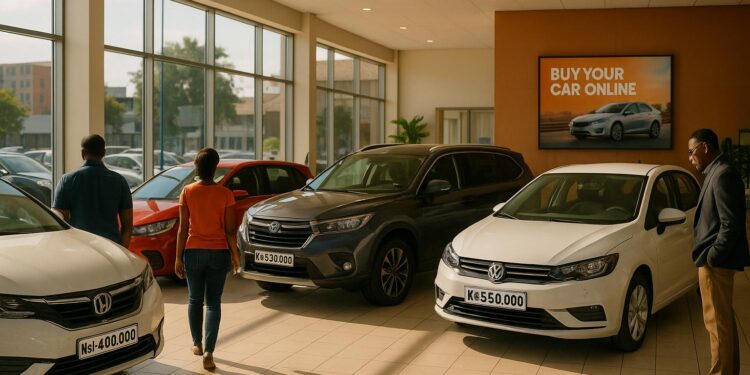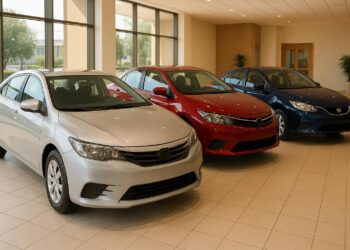Car prices in Kenya are rising in 2025, driven by import taxes, currency exchange rates, and government rules. Here’s what you need to know:
- Import duties and taxes: These significantly increase costs for both new and used cars.
- Currency fluctuations: A weaker Kenyan Shilling raises import prices.
- Market demand: Buyers prefer used cars due to affordability, but stricter rules like the 8-year age limit on imports are pushing prices higher.
- New vs. used cars: New cars start at $13,000+, while used options range from $2,000 to $15,000.
- Online platforms: Digital tools are improving price transparency and expanding choices for buyers.
If you’re buying a car this year, keep an eye on currency trends, compare options online, and plan your purchase carefully to avoid overspending.
Prices of Cars in NAIROBI 🇰🇪 KENYA! 2025 models from JAPAN 🇯🇵
What Affects Car Prices in Kenya
Kenya’s car prices in 2025 are shaped by several key factors. These elements not only explain the price differences but also guide decisions between buying new or used vehicles.
Import Duties and Excise Taxes
Government-imposed import duties and excise taxes are a major contributor to car prices. These fees are added directly to the cost of both new and used imported vehicles, significantly impacting their final price. Keeping an eye on regulatory changes in Kenya is essential, as updates can directly affect what you’ll pay.
Currency Exchange Rates
The exchange rate between the Kenyan Shilling and the US Dollar has a direct impact on car prices. When the Shilling weakens against the Dollar, import costs rise, pushing up prices across all vehicle categories. Following exchange rate trends can help you predict potential price shifts.
Market Demand and Government Rules
Consumer demand and government policies also play a big role in determining car prices. For instance, preferences for certain models, fuel efficiency standards, and restrictions on the age of imported cars influence both availability and cost. These factors are especially important when weighing options between new and used vehicles.
To stay ahead, follow updates from trusted local automotive news sources and official announcements, as regulatory changes can have a big impact on pricing.
New vs Used Car Prices in 2025
When it comes to deciding between a new or used car, your budget, needs, and long-term plans play a big role. By understanding the price differences and trade-offs, you can make a choice that aligns with your situation. Let’s dive into the details to compare the costs, benefits, and the impact of regulations.
Price Gaps Between New and Used Cars
In Kenya, the price gap between new and used cars is striking. A new car typically costs over $13,000, while used imports from countries like Japan and the UAE can start as low as $2,000. This means new cars can be up to six times more expensive than their used counterparts.
Used cars generally range from $2,000 to $15,000, depending on factors like the model, year, and condition. For instance, a Nissan Sentra costs between $8,000 and $12,000 when new, while a Mazda 3 ranges from $10,000 to $15,000. In the used market, these same models are available at more affordable prices, making them a popular choice for middle-class buyers.
Kenya’s used car market is valued at roughly $1.25 billion in 2025, showing a strong preference for pre-owned vehicles. In comparison, the new car market generates just $89 million in revenue, with projections indicating a slight decline to $86 million by 2029.
New vs Used Cars: Pros and Cons
Both new and used cars have their own set of perks and drawbacks, each influencing the overall cost of ownership. Here’s a side-by-side look at key factors:
| Factor | New Cars (2025) | Used Cars (2025) |
|---|---|---|
| Cost | High upfront cost ($13,000+) | Lower ($2,000–$15,000) |
| Depreciation | Rapid in first 2–3 years | Slower, already depreciated |
| Warranty | Full manufacturer warranty | Limited or no warranty |
| Resale Value | Drops significantly in 2–3 years | More stable, less depreciation |
| Financing | Easier, with more options | Fewer financing options |
| Choice | Latest models and technology | Wider variety, including older models |
| Regulations | Meets the latest standards | Must be under 8 years old |
New cars come with the advantage of manufacturer warranties, advanced safety features, and easier financing options. However, they lose value quickly in the first few years due to steep depreciation.
On the other hand, used cars hold their value better since the initial depreciation has already occurred. Buyers also enjoy a broader selection of models and trims within the same budget. The downside? Limited or no warranty and the possibility of higher maintenance costs as the car ages, especially near the 8-year import limit.
How Age Limits Affect Used Car Imports
Kenya’s 8-year age limit on used car imports directly impacts both pricing and availability. This regulation limits access to older, more affordable vehicles that many buyers rely on.
In January 2025, stricter enforcement of this rule led to higher overall prices. While this benefits organized dealerships that can finance newer stock, it creates challenges for budget-conscious buyers who previously found options under $2,000.
The 8-year rule creates a bottleneck for vehicles aged 7 to 8 years, as they lose eligibility just as they hit their best value. This forces buyers to either pay more for newer used cars or consider financing a new vehicle instead.
Japanese and UAE imports continue to dominate the used car market due to their right-hand drive setup and reputation for reliability. However, the 8-year limit means these vehicles must be relatively recent models, keeping prices higher than they might be in a less restricted market.
sbb-itb-e5ed0ed
Top Car Models and Price Ranges
Budget Car Models
Kenya’s 2025 car market offers several affordable options for buyers looking for budget-friendly vehicles. Here are some standout models and their price ranges:
- Honda Fit: $2,500 to $6,000
- Toyota Passo: $2,200 to $5,500
- Suzuki Alto: $2,000 to $4,800
- Nissan March (Micra): $2,800 to $6,200
These prices depend on factors like the car’s condition, mileage, and model year. Up next, we’ll dive into mid-range and luxury models to give you a broader picture of the 2025 market.
How Online Platforms Change Car Pricing
Kenya’s automotive market is undergoing a shift, thanks to the rise of online platforms. These digital tools are making car pricing more transparent, expanding the range of available vehicles, and encouraging dealers to rethink their strategies. The result? A more informed and efficient marketplace.
Benefits of Online Car Markets
Online car marketplaces are changing the game in Kenya, especially when it comes to pricing. One of the biggest perks is price transparency. Buyers can quickly compare prices from multiple sellers, which helps curb the inflated pricing often seen at traditional dealerships.
Another advantage is the broader selection of vehicles. Instead of being stuck with options at local dealerships, buyers can browse cars from across the country. This wider reach creates competition, which naturally drives prices closer to fair market values. Plus, online sellers typically have lower overhead costs, which often translates to better deals for buyers.
Online Car Sales Trends for 2025
More and more Kenyan car buyers are turning to digital platforms, a trend that gained traction during the pandemic. One key development is the growing demand for vehicle history reports. Buyers now expect details like maintenance records, ownership history, and accident reports before committing to a purchase. This push for transparency ensures that prices align more closely with a car’s actual condition.
Mobile-first platforms are also playing a big role. Buyers can now research and compare prices anytime, anywhere. Add digital payment options and online financing into the mix, and the entire process becomes faster and more convenient, cutting down on lengthy negotiations.
Social proof – in the form of reviews and ratings – has also become a pricing factor. Sellers with glowing reviews can often charge more, while those with negative feedback may lower their prices to stay competitive.
The pandemic may have accelerated this digital shift, but it’s clear that these changes are here to stay. With increased transparency, mobile accessibility, and smoother transactions, Kenya’s automotive market is set to continue evolving, reshaping how cars are priced and sold.
Key Points for 2025 Car Buyers in Kenya
If you’re planning to buy a car in Kenya in 2025, there are a few key factors to keep in mind. Vehicle prices are heavily influenced by import duties, excise taxes, and currency fluctuations. These elements play a major role in shaping the decision between purchasing a new car or opting for a used one.
Kenya’s age restrictions on imported vehicles further narrow the options for used cars. While this may limit potential savings, it also shifts the dynamics of the market. It’s worth weighing these factors carefully when making your decision.
On the bright side, digital innovation is making it easier than ever to shop smart. Platforms like AUTO24.co.ke, set to launch soon, aim to bring more transparency to the market. They’ll allow buyers to access inspected and verified used cars online, making it simpler to research before heading to a dealership.
To get the best deal, consider timing your purchase strategically. Keep an eye on currency trends, avoid peak buying seasons, and take advantage of online competition. Comparing options and thoroughly verifying vehicle details are essential steps to ensure you make an informed choice.
FAQs
How do import duties and taxes affect the prices of new and used cars in Kenya?
Import duties and excise taxes heavily influence the cost of both new and used cars in Kenya. These charges depend on factors like the car’s age, engine size, and its customs valuation – a figure that includes the cost of the vehicle, insurance, and freight (CIF). For instance, newer cars typically attract higher excise taxes, while older models may face additional environmental fees.
When combined with other expenses like currency exchange rates and shipping costs, these taxes can greatly inflate a car’s final price. It’s important for buyers to factor in all these costs when planning their vehicle purchase in Kenya.
How can I make the most of online platforms when buying a car in Kenya in 2025?
When shopping for a car online in Kenya in 2025, trusted platforms like AUTO24.africa and AUTO24.co.ke are excellent options to explore. These websites offer a broad range of vehicles, from brand-new models to pre-owned cars, and include helpful features like inspection and verification services to ensure a secure and transparent buying process.
As you browse, take time to compare prices, review vehicle histories, and focus on certified listings to avoid unexpected issues. Using these tools can guide you toward making smart decisions and finding a car that meets both your preferences and budget.
How does Kenya’s 8-year age limit on imported used cars impact pricing and buyer options?
Kenya’s rule that limits imported used cars to those no older than 8 years has a noticeable impact on both the prices and choices available to buyers. By allowing only vehicles manufactured within the past 8 years, the regulation ensures a supply of newer, more dependable cars on the roads. However, it also reduces access to older, more budget-friendly options.
For buyers, this means cars that meet the 8-year cutoff often come with higher price tags, reflecting their newer condition and compliance with the import rules. This restriction also increases demand for popular models within the allowed age range, which can further drive up prices. If you’re in the market for a car, it’s worth weighing these factors carefully to find the right balance between cost and your preferences.
Related Blog Posts
- FAQ: Importing Used Cars to Kenya in 2025
- Car prices in Nairobi 2025
- Most sold cars in Kenya this year
- The True Cost of Owning a Car in Kenya: Fuel, Maintenance & More




